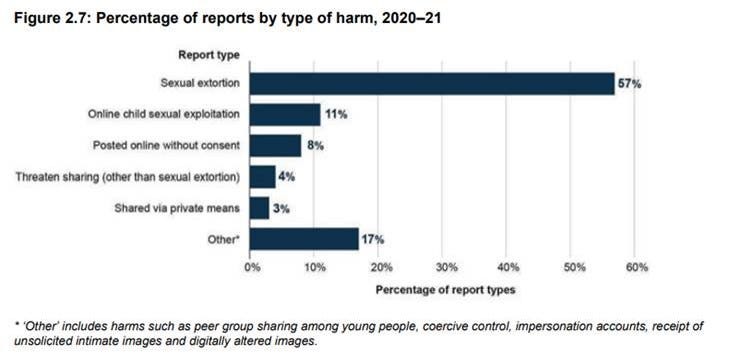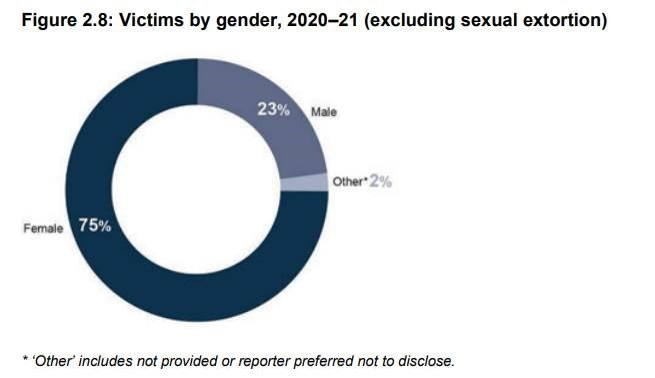
Now here's a funny thing. Take a look at this photo of the four people heading up Australia's Digital Platforms Regulators. The control of our county's high tech online business is firmly in the hands of women. Not a skerrick of gender diversity to be seen.
The cheerful long-haired blond is Julie Inman Grant, the powerful eSafety Commissioner whose 435 employees are beavering to keep our citizens safe online. The only problem is her cosy crew are devoting most of their efforts and $31m annual budget not to trying to protect us all from online abuse. Oh no, Ms Inman Grant has her own agenda.
Advertisement
"Technology is routinely being weaponised against women to demean, control and ultimately silence them," she pronounced at a National Summit on Women's Safety late last year. She justified her organisation's special focus on the fair sex by claiming that "Women are disproportionately targeted in every form of online abuse we deal with at eSafety."
Note that careful language – "every form of abuse we deal with at eSafety." Well, that's a bit of a give-away. Let's look at what exactly they choose not to deal with.
Last month the Australian Federal Police took the unusual step of releasing police intelligence to warn of "a spike in the number of Australian boys being preyed on by international sex offenders, who are grooming them into producing explicit images and then extorting them for money. They explained that reports have more than quadrupled between mid-2021 and this year. Similar warnings earlier in the month were issued by West Australian Consumer protection and WA police.
The problem is global and can lead to tragic consequences. The FBI recently issued similar warnings following the suicide of two 17-year-old boys, one in California, the other in Michigan. Watch this tragic CNN news video about Ryan Stuart, the San Jose boy, who received an online message in February from someone posing as a girl. The scammer sent Ryan a nude photo and asked him to share an explicit image of himself in return. As soon as Ryan sent the requested dick pic, the cybercriminal demanded $5,000, threatening to make the photo public and send it to Ryan's family and friends. The teenage boy told the scammer he could not pay the full amount, and the demand was eventually lowered to $150. But after Ryan paid that to the scammers using his college savings, they kept demanding more. Ryan wrote a desperate note saying he was absolutely terrified of the pictures being posted online, describing how embarrassed he was for himself and the family, and then took his own life – within hours of receiving the initial communication.
As Australian police made clear, that's a risk here too, with clever scammers preying on desperate boys who have nowhere to turn.
The inconvenient truth is buried by eSafety
Advertisement
Where's Ms Inman Grant and her eSafety team? Well, they've been busy, releasing their recent report on "how online abuse impacts women in their working lives" and other sundry items, but there's been not one word about boys in recent media releases. Inman Grant and her colleagues were nowhere to be seen when Kochie and mates on Channel 7 breakfast television chatted to a Federal Police spokesperson about boys being targeted.
It isn't as if the eSafety crew don't know about the sextortion problem. Back in February 2019, Ms Inman Grant was quoted by the ABC explaining a new eSafety survey showed seven of ten victims of online sextortion were male, although she downplayed this by diverting attention to cases aimed at eliciting sexual favours, where the victims are more likely to be underaged girls.
The most recent annual report from eSafety includes this graph showing that sexual extortion cases outnumber all other "image-based" online abuse complaints put together.

Judging from this, sexual extortion of males should be right up there in eSafety's core business.
That's just not going to happen. The next graph in that report claimed to represent the gender breakdown of victims of image-based abuse. Yet, in a revealing sleight of hand, they excluded sexual extortion. They left out the form of abuse which accounts for most (57%) of the total problem so they could proudly claim "victims of image-based abuse were predominantly female."

There is a section on the eSafety website which gives advice on dealing with sexual extortion, but this includes not one word suggesting boys are particularly vulnerable. The advice features one of the very rare male photos, midst a website festooned with images of women and girls, but the featured story concerns 40-year-old Michael who is blackmailed by a woman he met through online dating – nothing to do with the story being currently highlighted by the police.
Proud newcomer in the domestic violence politburo
Keeping all the emphasis on female victims is essential to eSafety's main game, which is all about establishing themselves as the high-tech arm of the domestic violence industry.
Julie Inman Grant's speech last September to the National Summit of Women's Safety was a big deal. She was the keynote speaker for this powerful gathering, which brings together key players to plot the new domestic violence national plan – following up their previous plan which attracted $3 billion in government funding over the previous decade.
Like the proud mother of new child, Inman Grant was there to celebrate her contribution to the powerful industry, which has already achieved such remarkable expansion in the list of behaviour enshrined into law as domestic violence, adding to initial territory focussed on purely physical abuse by claiming new types of villainy – psychological, emotional, financial, "threats" of abuse, and their latest coup, coercive control.
Inman Grant's baby is TFA or "technology-facilitated abuse." As she explained, "technology being used to isolate, harass, monitor, stalk, impersonate, threaten or humiliate someone else… It may take many forms including sharing or threatening to share intimate images and using tracking devices, voice recorders or cameras - which can be hidden in cars, children's toys, or even on the undersides of prams." Wow, how's that for a chilling threat, tracking a baby's pram?
According to Inman Grant, TFA is overwhelmingly gendered – "with the victims almost always women and abusers almost always men." She claimed online abuse of women is different from that targeting men – "It tends to be violent, sexualised, focused on appearance, and may question a women's supposed virtue or even their fertility."
Like the other forms of domestic violence which we are assured keep most women in a state of terror, here too we are told women everywhere are affected. Gendered TFA is universal, they claim, with almost 60% of all girls worldwide experiencing some form of online sexual harm. Inman Grant earnestly informs her eager audience that "4 in 5 Australian women have or are experiencing some form of technology-facilitated abuse."
Here was this outstanding achiever making her big sales pitch to the heavy hitters, boasting how much her organisation was already contributing to their vital work. For instance, e-Safety claims on their website that they run "evidence-based education programmes" but, as Inman Grant explained, what that means is training for domestic violence support workers: "Through our eSafety Women program, we have successfully trained thousands of frontline, specialist and support staff in the domestic violence sector."
The lobbying has already achieved funding in the last budget of $16.6 million over four years to establish a new telephone service to provide support for women and children experiencing technology facilitated abuse – which you might have assumed would include male victims of sextortion, but let's not hold our breath. Laws introduced last year to protect people from extreme online abuse were aimed solely at women and girls, and planned programs to increase teen's skills in online safety and digital literacy also will exclude males.
It is clearly not on Inman Grant's agenda to advertise the fact that her own organisation has discovered that one of the most prevalent forms of technology-based abuse is sexual extortion of males. After all, this woman was first appointed to her job by the Turnbull government, with Minister Michaelia Cash announcing that "this is about empowering women to take control online."
Just as the domestic violence industry does a skilled job denying women's role in family violence by misrepresenting statistics and denying research, eSafety strenuously avoids the evidence that would muddy Inman Grant's claim that TFA targets mainly women. Such as:
· Studies in USA, Norway and Australia have proven that men are more likely than women to be victims of online harassment.
· Men and women are equally likely to be victims of image based abuse according to the Australian Gendered Violence and Abuse Research Alliance – a result confirmed by American research.
· Half of misogynistic tweets are made by women.
· Online bullying happens to teens equally – both boys and girls.
The truth is that like girls, boys are being publicly shamed through ex-partners sharing their intimate photos. They too receive unflattering comments online about their bodies and appearance and find themselves the butt of online jokes about their sexual prowess. We all know about the mean girls who once dominated school playgrounds. These girls now bully and humiliate other youngsters in the online spaces which now dominate teenager's social lives.
Given that there's barely a mention of male victims on the eSafety website, there's no way this mob will be promoting this excellent resource set up by the Federal police to help vulnerable kids, mainly boys aged 13-17, learn about sexploitation, showing exactly how the scammers operate and how to deal with it, including making reports to the relevant authorities.
If you are a parent or grandparent with teenagers in your family, you should get your kids, particularly the boys, to read it through and tell their friends about it. It's the isolation and feelings of shame experienced by boys being targeted by these vicious scammers that puts them so at risk. It's a pity the organisation charged with protecting them has clearly turned its back on them.